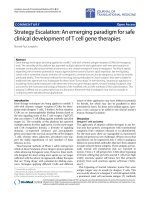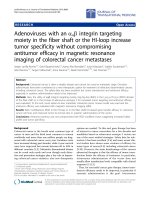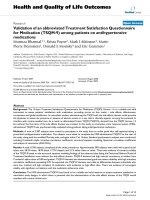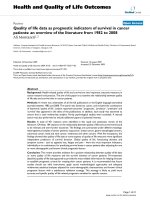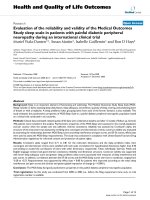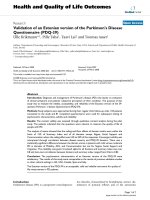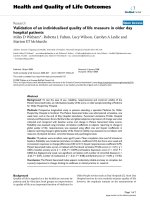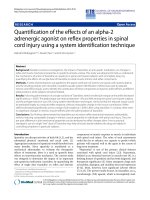Báo cáo hóa học: " Optimization of an Electron Transport Layer to Enhance the Power Conversion Efficiency of Flexible Inverted " ppt
Bạn đang xem bản rút gọn của tài liệu. Xem và tải ngay bản đầy đủ của tài liệu tại đây (310.74 KB, 5 trang )
SPECIAL ISSUE ARTICLE
Optimization of an Electron Transport Layer to Enhance
the Power Conversion Efficiency of Flexible Inverted Organic
Solar Cells
Kang Hyuck Lee
•
Brijesh Kumar
•
Hye-Jeong Park
•
Sang-Woo Kim
Received: 24 June 2010 / Accepted: 17 August 2010 / Published online: 31 August 2010
Ó The Author(s) 2010. This article is published with open access at Springerlink.com
Abstract The photovoltaic (PV) performance of flexible
inverted organic solar cells (IOSCs) with an active layer
consisting of a blend of poly(3-hexylthiophene) and [6, 6]-
phenyl C
61
-butlyric acid methyl ester was investigated by
varying the thicknesses of ZnO seed layers and introducing
ZnO nanorods (NRs). A ZnO seed layer or ZnO NRs grown
on the seed layer were used as an electron transport layer
and pathway to optimize PV performance. ZnO seed layers
were deposited using spin coating at 3,000 rpm for 30 s
onto indium tin oxide (ITO)-coated polyethersulphone
(PES) substrates. The ZnO NRs were grown using an
aqueous solution method at a low temperature (90°C). The
optimized device with ZnO NRs exhibited a threefold
increase in PV performance compared with that of a device
consisting of a ZnO seed layer without ZnO NRs. Flexible
IOSCs fabricated using ZnO NRs with improved PV per-
formance may pave the way for the development of PV
devices with larger interface areas for effective exciton
dissociation and continuous carrier transport paths.
Keywords Inverted organic solar cells Á ZnO nanorods Á
Electron transport layer Á Photovoltaic Á Short circuit
current density
Introduction
Organic solar cells (OSCs) have been widely investigated
in the past decade due to their numerous potential advan-
tages including relatively inexpensive and light-weight
materials, compatibility with flexible plastic substrates, and
ease of fabrication [1–3]. However, the short exciton-dif-
fusion length and inefficient exciton dissociation in a
polymeric matrix of OSCs results in low quantum effi-
ciency, which limits their use in many potential applica-
tions [4, 5]. Moreover, the lifetimes of OSC devices are
short, and thus careful encapsulation strategies should be
developed for use in practical working environments [6–8].
For the efficient dissociation of excitons, a bulk hetero-
junction (BHJ) blend of donors and acceptors is generally
used, leading to nanoscale morphology and facilitating
charge transport in interpenetrating networks [8–10].
In the conventional structure of an OSC based on BHJ,
indium tin oxide (ITO) modified with p-type poly(3,
4-ethylene dioxythiophene):(polystyrene sulfonic acid)
(PEDOT:PSS) is used as an anode [11]. However,
PEDOT:PSS is an acidic water-based solution, which
causes interface instability in the photoactive layer and
corrosion of the ITO [11, 12]. To improve the interface
stability and prevent device degradation, an alternative is to
use as an inverted configuration [13], with ITO serving as
the cathode and a high work function metal as the anode. It
should be pointed out that only modified ITO can serve as
the cathode for electron extraction, and thus the functional
layers for modifying ITO mainly focus on metal oxides.
ZnO is one of the applicable functional metal oxides for
use in this application due to its high electron mobility and
high degree of transparency in the visible wavelength
range. Moreover, its crystal structure allows it to be grown
anisotropically, making possible the production of highly
K. H. Lee Á B. Kumar Á H J. Park Á S W. Kim
School of Advanced Materials Science and Engineering,
Sungkyunkwan University, Suwon 440-746, Republic of Korea
S W. Kim (&)
SKKU Advanced Institute of Nanotechnology (SAINT)
and Center for Human Interface Nanotechnology (HINT),
Sungkyunkwan University, Suwon 440-746, Republic of Korea
e-mail:
123
Nanoscale Res Lett (2010) 5:1908–1912
DOI 10.1007/s11671-010-9769-9
efficient OSCs based on vertically oriented ZnO nanorods
(NRs) for use as continuous electron transport pathways
[14, 15].
Herein, we report a dramatic increase in the power
conversion efficiencies (PCE) of flexible inverted OSCs
(IOSCs) fabricated with ZnO NRs/ZnO seed layers acting
as direct electron transport pathways. This method involves
the growth of ZnO NRs via an aqueous solution route at the
low temperature of 90°C. This is a simple and effective
process for improving the PCE of IOSCs. Compared with
ZnO seed layer-based IOSCs, the PCE of the IOSCs fab-
ricated with ZnO NRs was increased by approximately
threefold using simulated air mass (AM) 1.5 global full-sun
(1.5G, 100 mW/cm
2
) illumination. This work suggests a
method to fabricate efficient photovoltaic (PV) devices
with larger interface areas for effective exciton dissociation
area and optimum continuous carrier transport paths, which
should be useful for future applications.
Experimental Section
We first prepared a ZnO seed solution using zinc acetate
dihydrate [Zn(CH
3
COO)
2
Á2H
2
O] as a source and ethanol as
a solvent. Briefly, zinc acetate dihydrate (final concentra-
tion 30 mM) was stirred for 30 min in ethanol at 60°C.
ZnO seed layers were then deposited using spin coating at
3,000 rpm for 30 s onto ITO-coated polyethersulphone
(PES) substrates. Spin coating was repeated between 12
and 18 times in order to control ZnO seed layer thickness
and density. The deposited seed layers were thermally
treated at 150°C for 10 min after each deposition. After
seed layer formation, the substrates were maintained in a
solution consisting of deionized water, 25 mM zinc nitrate
hexahydrate [Zn(NO
3
)
2
Á6H
2
O], and 25 mM hexamethy-
lenetetramine [C
6
H
12
N
4
] (HMT) for 30 min at 90°Cto
prepare the ZnO NRs.
We prepared a P3HT: PCBM-blended solution for
active layer deposition using spin coating at 2,000 rpm for
120 s. Poly(3-hexylthiophene) (P3HT) and [6,6]-phenyl
C
61
butyric acid methyl ester (PCBM) were dissolved in
chlorobenzene at a weight ratio of 1:1 for 1 day, resulting
in a P3HT:PCBM blend. After annealing an active layer for
30 min at 150°C, a 20-nm-thick MoO
x
electron blocking
layer and a 100-nm Au layer were deposited via thermal
evaporation through a shadow mask.
The structure of the IOSCs consisted of Au/MoO
x
/
P3HT:PCBM/ZnO, a NR/ZNO seed layer, and ITO/PES
stacked from bottom to top. Investigation into surface
morphology and thickness was carried out using field
emission scanning electron microscopy (FE-SEM). PV
performance was evaluated by measuring short circuit
current density (J
sc
), open circuit voltage (V
oc
), fill factor
(FF), power conversion efficiency (PCE) and series resis-
tance(R
s
) using a solar simulator under AM 1.5G condi-
tions (100 mW/cm
2
).
Results and Discussion
The cross-sectional FE-SEM images depicted in Fig. 1
show the typical surface morphologies of the ZnO NRs
grown on (a) 12 times, (b) 15 times, (c) 18 times deposited
ZnO seed layers using spin coating. The thickness of the
ZnO seed layer was increased by repeating the spin coating
process. The ZnO seed layers were porous and consisted of
nanoparticles with a typical diameter of 5 nm. The thick-
nesses of the seed layers were 115, 130, and 145 nm after
12, 15, and 18 spin coating depositions, respectively. The
ZnO NRs were vertically arrayed on the ZnO seed layer
with a typical diameter of 30 nm and a length of 250 nm.
Fig. 1 FE-SEM images of ZnO NRs grown on a ZnO seed layer spin
coated onto a PES substrate a 12 times, b 15 times, c and 18 times
Nanoscale Res Lett (2010) 5:1908–1912 1909
123
We fabricated a series of devices with different ZnO
seed layer thickness by controlling the number of spin
coating depositions. To investigate the role of the ZnO NRs
alone, we also fabricated IOSCs with ZnO NRs at the same
ZnO seed layer positions. Figure 2 shows the schematic
diagram of flexible IOSC and its energy band configura-
tion. The ZnO NRs and seed layer acted as an electron
transport layer, while the MoO
x
layer acted as a hole
transport layer.
Fig. 3 shows the current density–voltage (J–V) charac-
teristics for the solar cells fabricated with/without ZnO
NRs by varying the ZnO seed layer thickness. Measure-
ments were carried out under solar-simulated AM 1.5 G
illumination with a 100 mW/cm
2
light source. The J
sc
,V
oc
,
FF, and PCE derived from J–V curves are summarized in
Table 1. We found that PV performance improved as seed
layer thickness increased for the IOSCs fabricated with the
ZnO seed layer, up to an optimum thickness of 130 nm. In
IOSC structures, the electron transport layer is affected by
injection of holes from the highest occupied molecular
orbital (HOMO) level of P3HT—4.8 eV to ITO—4.8 eV
[16]. Therefore, to prevent contact between the active layer
and the ITO electrode, the ZnO seed layer should exist as a
stable compact film. However, the ZnO seed layer was a
porous film consisting of nanoparticles and could not
completely prevent contact between the organic active
layer and the ITO electrode until it reached an optimized
thickness. On the other hand, resistance of the seed layer
increased with increasing thickness. As a result, the J
sc
of
the device increased up to the optimum film thickness, after
which it began to decrease due to a larger series resistance,
as shown in Fig. 3. Consequently, the PV performance of
the device varied in the same way. Thus, an optimization
process was necessary with respect to the thickness of the
electron transport layer in order to prevent contact between
the active layer and the ITO electrode with the lowest
series resistance. We optimized the seed layer thickness to
130 nm, which allowed for the extraction of the maximum
efficiency from the device. Furthermore, we studied the PV
performances of IOSCs fabricated with a ZnO seed layer
and with a ZnO NRs/ZnO seed layer.
We also compared IOSCs with a ZnO NRs/ZnO seed
layer with IOSCs consisting of a ZnO seed layer only. As
summarized in Table 1, the PV performance of the IOSCs
fabricated with a ZnO NRs/ZnO seed layer was improved
about threefold compared with that of IOSCs fabricated
with a ZnO seed layer. This substantial improvement in
PV performance can be explained in two ways. First,
improvement in PV performance was the result of an
increased exciton dissociation interface area between ZnO
and the active layer using ZnO NRs. The energy level
Fig. 2 Device structure and energy diagram of IOSC with ZnO NRs
Fig. 3 Current density voltage (J–V) characteristic for solar cells
under AM 1.5 G simulated solar illumination
Table 1 Summary of device performance
Devices ZnO seed layer thickness (nm) J
sc
(mA/cm
2
)V
oc
(V) FF (%) PCE (%)
ZnO seed layer 12 times 115 2.492 0.211 36.637 0.193
ZnO seed layer 15 times 130 3.250 0.220 36.212 0.259
ZnO seed layer 18 times 145 2.817 0.200 36.308 0.205
ZnO NRs/ZnO seed layer 12 times 250/115 8.900 0.259 35.955 0.829
ZnO NRs/ZnO seed layer 15 times 250/130 9.917 0.266 37.126 0.979
ZnO NRs/ZnO seed layer 18 times 250/145 9.100 0.269 37.971 0.930
1910 Nanoscale Res Lett (2010) 5:1908–1912
123
diagram in Fig. 2 shows the position of the lowest unoc-
cupied molecular orbital (LUMO) level of ZnO at—4.2 eV
[17], which suggests that electrons from P3HT with a
LUMO of—2.7 eV [16] can be injected into the ZnO NRs.
Therefore, a larger area between ZnO and the active layer
is favorable for increased exciton diffusion and separation
events. For IOSCs with a ZnO seed layer, the exciton
dissociation interface between the ZnO seed layer and
organic material was planar, and most of the photo gen-
erated excitons were unable to reach the interface. This
resulted in a large recombination probability in locations
distant from the interface due to low exciton-diffusion
length. Conversely, for the IOSCs with a ZnO NRs/ZnO
seed layer, upon filling the space between the ZnO NRs
with organic materials, the exciton dissociation inter-
face area was greatly increased, and most of the photogene
rated excitons were able to reach the interface before
recombination.
A second possible reason is a higher mobility of the ZnO
NRs. High carrier mobility causes low series resistance
(R
s
), which increases the efficiencies of solar cells [18].
Because the series resistance in a solar cell contributes to
the bulk conductivity of each of the functional layers and
the contact resistance between them, and because high
charge carrier mobility is beneficial to obtaining a low R
s
[19], the lower R
s
of the IOSCs with the ZnO NR/ZnO seed
layer may reflect improved electron mobility. As demon-
strated in previous studies [4, 20], the carrier mobility of
ZnO NR is several orders of magnitude larger than that of
organic materials due to the occurrence of a hopping
mechanism in the organic materials [21]. Therefore, we
speculate that the dark current density in IOSCs with a ZnO
NRs/ZnO seed layer as a direct pathway for photo-gener-
ated electrons was increased compared with that of IOSCs
with a ZnO seed layer. Figure 4 shows the J–V curves
obtained for the IOSCs with a ZnO NRs/ZnO seed layer
and a ZnO seed layer under forward bias in the dark. The
current density of the IOSCs fabricated with ZnO NRs was
increased compared with that of IOSCs fabricated with a
ZnO seed layer, providing additional evidence for the
improvement in PV performance due to the introduction of
ZnO NRs.
Conclusions
PV performance of flexible IOSCs with an active layer
consisting of a blend of P3HT:PCBM was investigated by
varying the thicknesses of ZnO seed layers and by intro-
ducing ZnO NRs. A ZnO seed layer or ZnO NRs grown on
the seed layer were used as an electron transport layer and
pathway to optimize PV performance. The optimized
device with ZnO NRs exhibited a threefold increase in PV
performance compared with that of a device consisting of a
ZnO seed layer without ZnO NRs. The optimization of the
electron transport layer in the present work is one of the
most important aspects for further improvement on solar
cell efficiency.
Acknowledgment This research was supported by Basic Science
Research Program through the National Research Foundation of
Korea (NRF) funded by the Ministry of Education, Science and
Technology (2010-0015035 and 2009-0077682) and also by the New
& Renewable Energy of the Korea Institute of Energy Technology
Evaluation and Planning (KETEP) grant funded by the Korea gov-
ernment Ministry of Knowledge Economy (No. 2009T100100614).
Open Access This article is distributed under the terms of the
Creative Commons Attribution Noncommercial License which per-
mits any noncommercial use, distribution, and reproduction in any
medium, provided the original author(s) and source are credited.
References
1. W.L. Ma, C.Y. Yang, X. Gong, K. Lee, A.J. Heeger, Thermally
Adv. Funct. Mater. 15, 1617 (2005)
2. M. Reyes-Reyes, K. Kim, D.L. Carroll, Appl. Phys. Lett. 87,
083506 (2005)
3. F.C. Krebs, Sol. Energy Mater. Sol. Cells 93, 394 (2009)
4. W.B. Chen, H.F. Xiang, Z.X. Xu, B P. Yan, V.A.L. Roy, C.M.
Che, Appl. Phys. Lett. 91, 191109 (2007)
5. M.Y. Chan, S.L. Lai, M.K. Fung, C.S. Lee, S.T. Lee, Appl. Phys.
Lett. 90, 023504 (2007)
6. G. Dennler, C. Lungebschmied, H. Neugebauer, N.S. Sariciftci,
M. Latre‘che, G. Czeremuskin, M.R. Wertheimer, Thin Solid
Films 349, 511 (2006)
7. J. Fahlteich, M. Fahland, W. Scho
¨
nberger, N. Schiller, Thin Solid
Films 517, 3075 (2009)
8. D. Chirvase, J. Parisi, J.C. Hummelen, V. Dyakonov, Nano-
technology 15, 1317 (2004)
9. H. Hoppe, M. Niggemann, C. Winder, J. Kraut, R. Hiesgen, A.
Hinsch, D. Meissner, N.S. Sariciftci, Adv. Funct. Mater. 14, 1005
(2004)
Fig. 4 Dark current density voltage (J–V) curves for IOSCs
Nanoscale Res Lett (2010) 5:1908–1912 1911
123
10. H. Hoppe, N.S. Sariciftci, J. Mater. Chem. 16, 45 (2006)
11. M. Jorgensen, K. Norrman, F.C. Krebs, Sol. Energy Mater. Sol.
Cells 92, 686 (2008)
12. L.M. Chen, Z.R. Hong, G. Li, Y. Yang, Adv. Mater. 21, 1434
(2009)
13. D.C. Olson, J. Piris, R.T. Collins, S.E. Shaheen, D.S. Ginley,
Thin Solid Films 496, 26 (2006)
14. D.C. Olson, Y.J. Lee, M.S. White, N. Kopidakis, S.E. Shaheen,
D.S. Ginley, J.A. Voigt, J.W.P. Hsu, J. Phys. Chem. C 111, 16640
(2007)
15. D.C. Olson, S.E. Shaheen, R.T. Collins, D.S. Ginley, J. Phys.
Chem. C 111, 16670 (2007)
16. T. Yamanari, T. Taima, J. Sakai, K. Saito, Sol. Energy Mater.
Sol. Cells 93, 759 (2009)
17. L.J.A. Koster, W.J.V. Strien, W.J.E. Beek, P.W.M. Blom, Adv.
Funct. Mater. 17, 1297 (2007)
18. S.E. Shaheen, D.S. Ginley, G.W. Jabbour, MRS Bull. 30,10
(2005)
19. H.L. Yip, S.K. Hau, N.S. Baek, H. Ma, A.K Y. Jen, Adv. Mater.
20, 2376 (2008)
20. Z.Y. Zhang, C.H. Jin, X.L. Liang, Q. Chen, L M. Peng, Appl.
Phys. Lett. 88, 073102 (2006)
21. P. Sullivan, T.S. Jones, A.J. Ferguson, S. Heutz, Appl. Phys. Lett.
91, 233114 (2007)
1912 Nanoscale Res Lett (2010) 5:1908–1912
123

